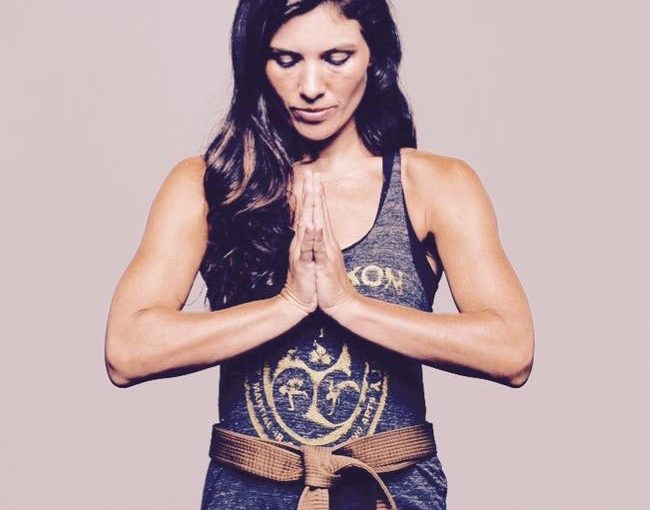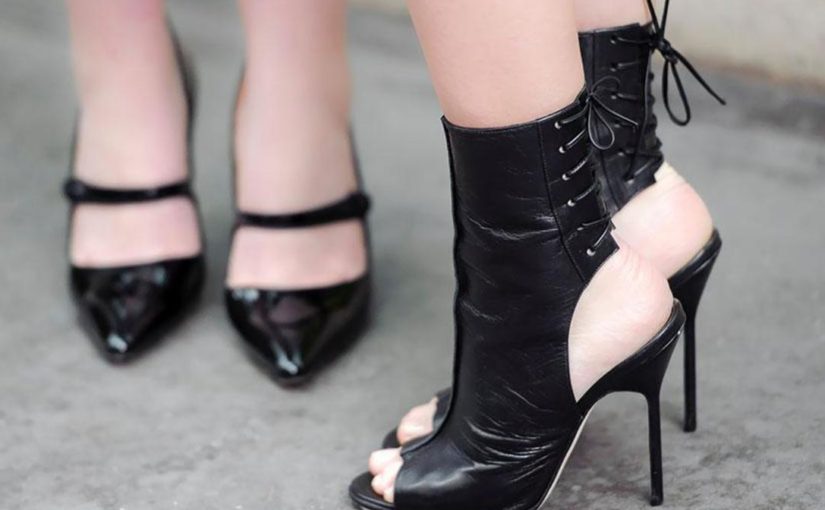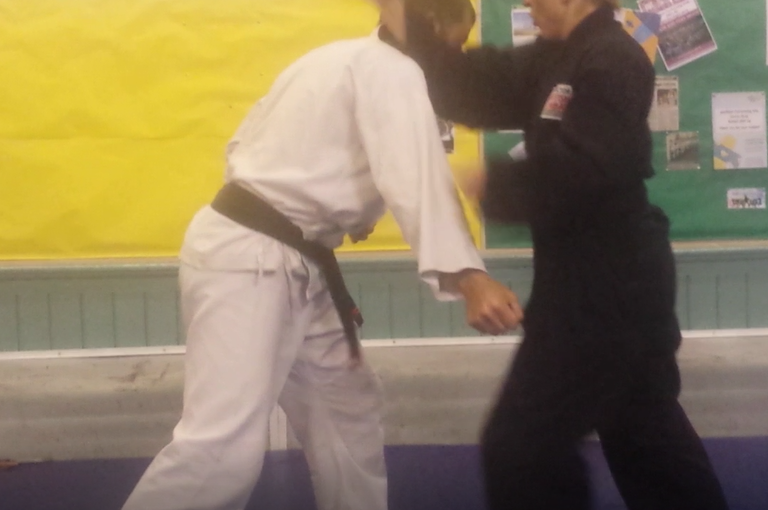Who is Angela Meyer? —————————————————- 2
Pushing Your Students and Red Lines —————————- 5
The Effects of Female Socialization ——————————– 7
Running and Personal Safety —————————————— 10
Female Interest in Women’s Self-Defense ———————– 14
Understanding Risk vs. Reward ————————————— 16
Boundary Setting: Communication and Enforcement —– 19
Fear and Anger —————————————————————— 21
Emotional State and Mental Images ———————————- 24
Erik: Please tell me a little about yourself. I am interested in hearing about your background and current activities.
Angela: Ha ha…these days if someone were to ask me that question, my answer off the bat would be to laugh and say, “it’s complicated, but I’m actually always working on the act of balance to make it ‘more simple’.
I was a collegiate soccer player, did not speak as a little girl, to the point of therapist wondering if some sort of “trauma” was involved in my “muteness.” Found voice through tapping into deeper currents through the team mentality of soccer and spirituality. After graduating college, I lived in Brazil favelas with a family for a year because I felt drawn to the “edges.” I got a Masters of Theological Studies from the Iliff School of Theology in Denver, CO and volunteered/ lived/ worked for over 10 years at an AIDS hospice in DC for homeless men and women called Josephs House. In this time span I also started teaching Yoga, and became an End of Life Counselor through the Metta Institute in San Fran. I left DC to live in NYC and study as a Buddhist Chaplain through the New York Zen Center for Contemplative Care. Working in the “liminal” space between life and death has been one of the most life-giving spaces for me, as it is “real”, and there is no “bull-shit.”
While I was in NYC I found, a practice called Budokon through a Yoga studio where I taught. That was my first introduction into Martial Arts. I had had therapist for years telling me I should do Martial Arts, and my response was always, “I don’t have time for another thing.” After my first taste of Martial Arts, I had visions of being Million Dollar Baby and trained seriously in all aspects since then.
Upon moving back to DC a year later, I trained very seriously in Krav Maga and MMA, Muay Thai, Jiu Jitsu, wrestling. From the beginning, I had a desire to compete, but I also suffer from anxiety which kept getting in the way. I also had to do a lot of internal work, around my identity of being a “caregiver.” All the work I had done professionally, was in an intense caregiving role. I had to work out internally what it meant to be a “caregiver” and also what it means to be “violent”. I wanted to fight so bad in a ring or cage, but didn’t think I’d be able to hit someone in the face, ground and pound and make them bleed. I had to work through my own inner violence, and integrate the feelings and meaning attached to it.
In the last year and a half…I finally stepped into a Muay Thai ring four times and am currently training for a fight at the end of April. Although the fear and anxiety is there every time, I’m learning more and more about my “limbic threshold” and through great coaching being able to access more than I thought was there.
I’ve trained in self-defense for the past six years through Fit to Fight, an organization that recently broke away from Krav Maga, but focuses on both Self-defense and training students to fight. I will be testing for my Black Belt this August in San Antonio.
Currently I teach Yoga, lead Yoga Teacher Trainings, teach a lot of Women’s Self-defense, travel and teach workshops with my partner who is also my coach. I normally train 3 hours a day and am always looking for balance which I’ve accepted is not a destination but a continual act. I am fascinated between the similarities in Yoga, Fighting (Martial Arts/Self Defense) and working with Death, breathing is the common thread.
I’ll stop there and we can continue.
Erik: Well, I had a suspicion that you had an interesting background and you definitely do.
In terms of women’s self-defense, what is the focus of your teaching? What is the primary message/take-away that you want your students to receive from your classes?
Angela: To stop waiting for prince charming or someone to come save them. To learn to be your own hero.
To stop apologizing away their lives and instead say, “I wish a mother fucker would.” To understand that it’s possible to still be fiercely compassionate and violent in the same moment. To not fear their own violence, but to channel it, creating boundaries, not just in a self-defense scenario, but every relationship in their lives. To say no when they want and yes when they want. To understand that if someone chose to attack them, they must dehumanize them…they have become an object, therefore no one cares how you “feel”, or if you are tired or don’t want to right now.
I want students to become more intimate with their perceived “red line”…the place where physically they think they have nothing more to give. They can’t go on…where they are highly uncomfortable…and I coach them to see if they can access more…to realize that they may just a little bit more to give. To understand that if someone crossed a line in the sand and they had to “fight”, no one would care if they were fucking tired, or uncomfortable, they just should go.
This comes full circle to the psychological work. The “pre-emptive” self-defense. Questions like What would you be willing to fight for? What are you fighting for currently? (doesn’t have to be physical), Could you kill someone? What would you be willing to do?
I think it is very important to do the “inner” work of self-defense, as well as the physical.
Erik: Please expand on what you mean by “I wish a motherfucker would…”
Angela: “I wish a mother fucker would” is of course used more for effect than a literal expression.
When I’m teaching, I make sure I clarify that I am not literally walking around the world, hoping someone will attack me. I am a small woman, and even though I “train” am under no assumption that size, terrain, surprise, weapons, etc, don’t matter, they do. I use this “phrase” to explain walking around as a woman with confidence. I explain to the women I teach, that after training in Self Defense/Fighting, I walk different on the streets of DC. I am still fully aware of my vulnerability, I just have a different awareness. If I am walking on the street and I hear someone sketchy coming behind me, I am more ready, more alert. I look if there are places I can run, are there other people around, is there anything I could use as a weapon? I want to show that I would not be an easy target. This is what I’m talking about when I say “ I wish a mother fucker would” mentality, like a game face on, even if inside my bones are shaking.
Erik: Based on what you said about pushing your students and their Red Lines.
How do you deal with the fact that what you really want to do is push these women both physically and mentally, but there is always the very real possibility that due to past history with trauma (or something else) that one or more of them will have an emotional breakdown?
This creates a situation in group training where the students are effectively limited by the weakest member(s) of the group.
For example, you simulate a high-pressure assault and the student breaks under the pressure. The result is that she ends off being psychologically worse off than before. Her confidence is lowered, not raised.
On the other hand, the other women in the group would benefit from dealing with having their limits pushed, tested, and ultimately expanded.
Many instructors deal with this issue by creating “fantasy fights” where everyone “wins” regardless of the effectiveness of their actions.
The side effect being that the students leave the training with an unrealistic assessment of their ability and never really get “tested”.
How do you deal with this problem?
Angela: Wow, these are great questions and very real ones. I have had several students who have had a history of trauma from mild to very severe and I think the key word is TRUST. I lead with a no bullshit approach, and I push students to their breaking points, but because of my background in Chaplaincy, hospice and counseling, I never do this without having first created a safe space.
I lead with ferocity but also a feminine energy (not meaning, because I’m a woman, just more circular). I sit the women down in a circle before we start, I share a little bit about my fear and vulnerability, not in a sense of oversharing, or being “soft”, but so that they will trust me. I tell them that I am okay holding any of their “feelings” and that my job is not for them to like me, but to ruffle their feathers.
That said, because I am a trained professional in creating community, safe spaces and counseling…I feel able to not baby women who have had past experiences, but go at their speed. Many of the women are also seeing therapist in conjunction with self-defense training. I’ve had so many different experiences and deal with them each on an individual basis, through deep listening and a mutual trust relationship. If I have not established trust or created a safe space, I would not be able to do this. I think that is why it can be so healing to have a Woman teach all women’s self-defense. In these environments, it can feel safe enough to break down, fall apart, get angry, and work through trauma. Even though my goal is to explore their limbic threshold through pushing physically and psychologically, I am also a fierce nurturer, and energetically embody a safe presence.
I also am not an advocate of protecting or babying women, but I don’t think it is black and white, especially when dealing with real trauma. This is where I think self-defense is such a personal journey and there are no “right and wrong” answers.
I do not change the intensity or ferocity of my teaching, but I am highly aware and sensitive, to those who have had prior experiences.
Sometimes I’ll have them work with specific people, like my assistants. I always provide techniques for self-care after. I also make sure to let these women know that they are in charge. I do not force anyone to go where they are not ready to go, but I work with them in an intimate way to take their power back…again, for each woman I’ve worked with, it’s been a personal journey.
So, I guess, my “circular answer” to your great question is…I could not do the work I do, I could not ask women to go to the places that scare them the most, if I did not first create trust and a safe space. This is one reason I think it is helpful to have female teachers of Self Defense. It’s hard to fully understand what it’s like to walk around the world as a woman if you are not one. Just like as a white woman, I can never understand fully what it means to walk around as a person of color.
End of Part I.






